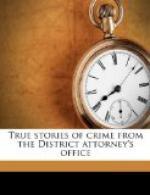Lapierre and Madame Reddon accordingly sailed for America and arrived in New York on the fourth of December, 1904, where they were met on the dock by the General, who, freshly barbered, and with a rose in his buttonhole, invited them, as soon as they had recovered from the fatigue of landing, to make a personal inspection of their properties.
These heirs to hundreds of millions of dollars were conducted by the “Marquis de la d’Essa and Count de Tinoco” to the Battery, where he gallantly seated them in an electric surface car, and proceeded to show them the inheritance. He pointed out successively Number 100 Broadway, the “Flatiron” Building, the Fifth Avenue Hotel and the Holland House, the Waldorf-Astoria, the Vanderbilt mansion at Fifty-seventh Street and Fifth Avenue, the Hotel Savoy and the Hotel Netherland, incidentally taking a cross-town trip to the ferry station at East Twenty-third Street, and to Bellevue Hospital. A public omnibus conveyed them around Central Park—also their own. And, in spite of the cold weather, the General insisted on showing them the “Tessier mansion and estate at Fort George”—visible from the Washington Bridge—“a beautiful property in the centre of a wood.” Returning, he took them to the Museum of Natural History and to the Metropolitan Museum of Art, which contained “Tessier’s collections.”
Having thus given them a bird’s-eye view of the promised land, the General escorted them to his apartments and allowed them to see the Ark of the Covenant in the shape of a somewhat dilapidated leather trunk, which contained a paper alleged to be the will of Jean Tessier, made in Bellevue Hospital (one of his possessions), and unlawfully seized by the Lespinasse family. It was only, Moreno alleged, through the powerful influence of the Jesuits that he had been able to secure and keep a copy of this will.
Although the Marquis de la d’Essa must have known that his days were numbered, he was as gay and as entertaining as ever. Then, suddenly, the scales began to fall from Madame Reddon’s eyes. The promised meeting with Marie Louise Lespinasse and her mysterious representative, “Mr. Benedict-Smith,” was constantly adjourned; the “police agents,” whom it had been so necessary to entertain and invite to saloons and cafes, were strangely absent, and so were the counsellors, Jesuit Fathers, bankers, and others who had crowded the General’s antechambers. A slatternly Hibernian woman appeared, claiming the hero as her husband; his landlady caused him to be evicted from her premises; and his trunk containing the famous “dossier” was thrown into the street, where it lay until the General himself, placing it upon his princely shoulders, bore it to a fifteen-cent lodging-house.




